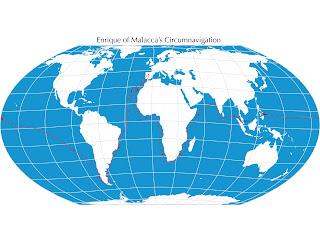 |
| Spanish Carrack. |
The San Antonio was the largest of the five ships in Ferdinand Magellan’s fleet and the most expensive. While the configurations of the five vessels are not known, the San Antonio was listed at 120 tons and a price of 330,000 maravedis. Compare that with Magellan’s flagship Trinidad, at 110 tons and a cost of 27,000 maravedis.
Armada de Molucca, Ship Sizes, Cost, and Crew
Juan de Cartagena
The San Antonio’s captain, Juan de Cartagena, was also Magellan’s biggest human challenge on the expedition. Cartagena was at the last minute also named inspector general of the fleet, a ploy by Castilian officials who distrusted the Portuguese Magellan and sought to control—or stop—him. (It was Spain’s newly crowned King Carlos I (Charles V) who agreed to back Magellan’s expedition, an 18-year-old from Flanders listening to Flemish advisers.)
The San Antonio carried a crew of 55 men at departure. Along with inspector general Cartagena they included an accountant, a notary, officers, a barber, two caulkers, a carpenter, a cooper (think barrels of wine), and a chaplain, as well as sailors, seaman, gunners, “boys,” “servants,” and the “extras,” often soldiers, as Magellan had been for Portugal in East Africa and India a decade earlier.
The majority of the San Antonio’s crew were Castilian, along with men from France, Greece, Sicily, and Flanders.
Cartagena’s threat to Magellan was more than just detailed accounting. Juan de Cartagena was a confidant and “nephew” (possibly illegitimate son) of Archbishop Juan Rodríguez de Fonseca, a relationship known in the fleet and one that Magellan had to respect—to a degree.
Once at sea, Cartagena openly defied Magellan’s authority, driving the captain-general to arrest him before they even crossed the Atlantic. Still a captive when the fleet reached Patagonia, Cartagena broke loose and returned to the San Antonio to lead a mutiny.
Mutiny at Puerto San Julian
Cartagena joined the Concepción's Captain Gaspar de Quesada, its pilot, Juan Sebastián Elcano, and 30 Spanish crew members to seize control of the vessel. Quickly the mutiny pitted three ships—the San Antonio, the Concepción, and the Victoria—against Magellan’s flagship Trinidad and the Santiago.
Although outnumbered, Magellan quickly prevailed in a battle at sea that included sending Duarte Barbosa to board the Victoria and retake it by force, a decisive surprise attack.
Magellan convened a court martial onshore at Puerto San Julian. Quesada was sentenced to death by beheading (and quartering afterward). Cartagena was spared the beheading, likely because of his relationship to Archbishop Fonseca. He was sentenced instead to be marooned along with a priest, Pedro Sánchez de la Reina, who was among the mutineers.
On August 11, 1520, Juan de Cartagena and Reina were left marooned on a small island off Puerto San Julian, left with only a small supply of sea biscuit and wine—this along a coastline where the fleet had already encountered cannibals and Patagonian “giants.”
To replace Cartagena as captain of the San Antonio, Magellan appointed Álvaro de Mesquita, his nephew and someone he could trust. But as the expedition forged ahead along the South American coast, discontent among the Castilians continued with it, despite the harsh punishments received by Cartagena and Quesada.
San Antonio’s Desertion
Late in October at the entrance to the strait, Magellan sent the San Antonio on a scouting run; the ship never returned. Two of its officers, Estêvão Gomes and Jerónimo Guerra, overpowered Mesquita and put him in chains, then forced him to sign a document reporting Magellan mistreated and murdered Castilian officers at Bahía San Julián.
Estêvão Gomes was Portuguese, like Magellan, but he had his own ambitions. In Seville Gomes had been promoting his own westward expedition to the Moluccas, a proposal that was passed over for Magellan’s. Gomes also felt slighted at not being appointed the new captain of the San Antonio after the San Julian mutiny.
Gomes got Guerra to take command of the San Antonio (Guerra was Castilian, a better image for a mutinied ship returning to Spain). They piloted back through the strait and on Nov. 14, 1520, reached the Atlantic, where they promptly sailed back across the Atlantic without stopping to look for Cartagena and the priest.
By John Sailors
Enrique's Voyage
Images
Top, Spanish carrack: By BPL - Ships Through the Ages Uploaded by Fæ, CC BY 2.0, https://commons.wikimedia.org/w/index.php?curid=15934945
(C) 2022, by John Sailors.
Review and Discussion Questions
For classroom review or self-study. After reading the article try first to answer these questions off the top of your head, then look back to answer any that you are unsure about.
1. What was the largest ship in Magellan's fleet, the Armada de Molucca?
2. Who was captain of the San Antonio?
3. Which of Magellan's ships mutinied?
4. Which of Magellan's ships deserted?
5. What happened to the San Antonio after Magellan's fleet discovered the Strait of Magellan?
- EnriqueOfMalacca.com
- Enrique of Malacca on Twitter
- Enrique of Malacca on Facebook
- John Sailors / Enrique on Medium
- And, yes, Enrique might be 500 years old, but he was known as a kid, so of course he's now on Instagram too.

